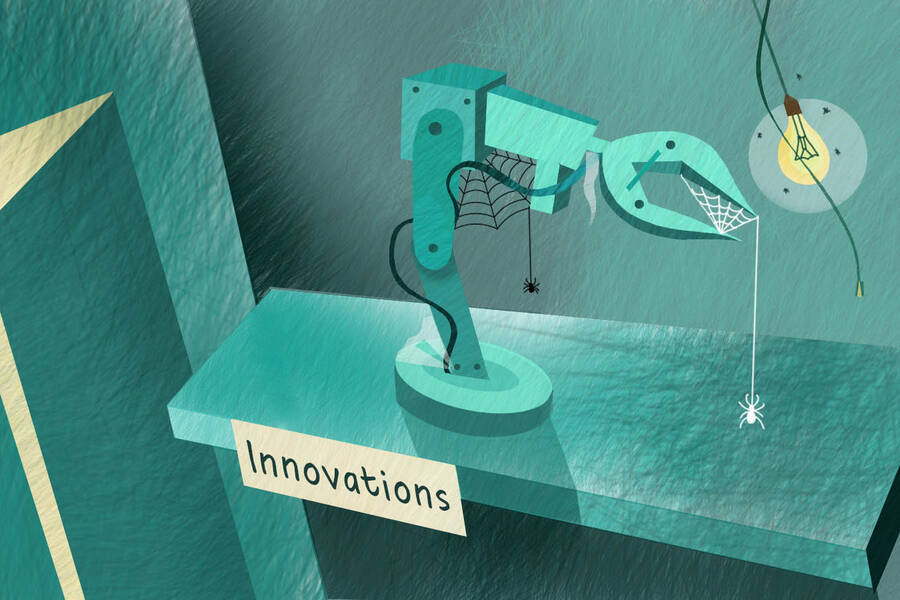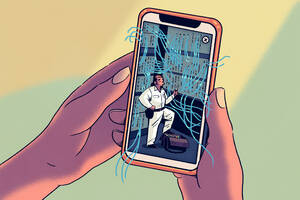Wang, a professor of management and organizations at the Kellogg School, took his first step into the metaverse.
“I put on the glasses, and I was like, ‘Oh my god, this is here,’” he recalls, laughing. “‘No wonder there’s so much investment in this: the technology is really here!’”
The metaverse is here, but what is it? Much like the internet in the 1970s and ’80s, the metaverse is gradually taking shape in a host of different applications, from gaming to surgery. But for the purposes of this article, it refers to an immersive three-dimensional environment that allows people to interact with others, as well as both physical and virtual phenomena, persistently through time.
Most people are aware of the technology’s applications in online gaming and meetings, but virtual reality, augmented reality, mixed reality, and other immersive tech are being used in manufacturing, healthcare, and other areas for training and research.
Still, the future of the metaverse is far from clear. After his visit to xreal, Wang became curious about what it might mean for his field. He runs the Center for the Science of Science & Innovation, a laboratory that uses big data and AI tools to reveal patterns in how science is studied and pursued, and what that means for creativity and innovation.
So Wang and his colleagues, then-postdoc and lead author Diego Gomez-Zara, now of Notre Dame, and Peter Schiffer of Yale University, put their heads together. “We thought about, what are the potential applications? How may this help science? What are the things we need to be careful about? Is this really an opportunity?” Wang says.
They found that while the metaverse offers exciting possibilities for research, there are a lot of potentially big problems to work out—and a plan is needed to develop the metaverse thoughtfully.
Promising opportunities
Wang and his colleagues believe the metaverse is poised to alleviate some of the challenges scientists currently face conducting research.
Accessibility. Currently, many scientists can’t afford the cost of attending far-flung conferences and other peer gatherings in person. Video conferencing is a workaround, but screens “filter out other stimuli that are essential in generating new ideas,” like serendipitous hallway conversations and paper-napkin brainstorming, Wang and his colleagues write. The 3D nature of the metaverse would facilitate these kinds of encounters. It could also enhance collaborative lab work. In personalized, immersive 3D environments, distant scientists are already starting to collaborate and work with the same instruments in the same virtual environments. For example, scientists at University College London’s School of Pharmacy have developed a digital replica of their lab that can be visited through virtual reality.
Training. Immersive technology is already helping research teams with training and learning, which has typically been conducted in environments prone to interruptions and where mistakes can be costly. Now, teams can use cameras and sensors installed in their real-world labs to capture their activities and create VR training programs. Such tools allow trainees to immerse themselves in a virtual lab and practice maintaining equipment, applying safety measures, and handling emergencies. Far from being how-to videos, these are fully immersive experiences. And when freely shared with other researchers, they can equalize training for labs with smaller budgets around the world.
Reproducibility. Reproducibility is the extent to which the results of an experiment stay consistent when the experiment is repeated under the same conditions. In-person experiments could be captured with sensors and headsets, then uploaded to the metaverse, enabling other scholars to experience the precise contexts and procedures in immersive 3D simulations. This would allow researchers to pinpoint differences between original experiments and attempted replications.
Understanding. VR technology can also help researchers study environments or scenarios that are prohibitively expensive or otherwise difficult, if not impossible, to produce in real life. This could involve creating involved immersive experiences for human participants; it could also be useful for animal research. In one VR platform, for example, flies move freely in a cylinder while images created by computational projections are displayed on the walls and floor, showing a virtual world that scientists can manipulate. These images allow researchers to see how the flies’ behavior and brain activity change in response to different stimuli.
Looming challenges
But immersive technology could also introduce some significant problems—ones that, if unaddressed, could outweigh any pluses.
Corporate control. Unlike the internet, a technology that grew out of academia and is owned by no one, metaverse applications and platforms are emerging from large tech companies. Wang worries that if this continues, corporate agendas and financial interests could control academic access to metaverse advantages.
“If we’re not careful, and we start to rely on the metaverse, then there could be a massive transfer of wealth going from public good to private companies,” Wang warns.
This could have sweeping and lasting impacts on metaverse access. What’s urgently needed, says Wang, are strong protections for independent metaverse capabilities. The research community will need to work together to make this happen, he says, whether by creating funding mechanisms that support access or establishing strong protections to ensure noncorporate research needs are met.
But safeguarding independent research in the metaverse won’t be enough unless it applies to everyone, he adds. Upfront investments in hardware and software, as well as training, will be easier at well-funded institutions and out of reach for many others. Wang urges government agencies and funders to level the playing field with competitive grants, infrastructure funding, and other support.
Validity. Immersive technology could affect the validity of scientific experiments that are conducted in the metaverse. What’s needed is a set of rules that governs how these virtual environments are built and used, as well as a process for validating virtual experimental results against physical results. Otherwise, any gains from improvements in scientific reproducibility could be undercut by producing results that don’t actually apply to the world in which we live.
Safety. Explicit safety norms and conduct codes will be needed to create a safe virtual environment for researchers, as well as study participants. Studies have shown immersive technology can cause nausea, fatigue, physical injury, addiction, and isolation for users. For human and animal subjects, the experiments simulated in the metaverse could introduce new avenues of unintended harm that we can’t yet envision. For example, the brain often perceives virtual threats as actual threats, so scientists will need to adapt existing protections to take this into account. Other safety issues, such as sexual misconduct, will also need to be addressed.
Policy protection
Now is the time to set policy for an immersive future, Wang says. Fortunately, we don’t need to start from scratch. For example, in late 2022, South Korean lawmakers proposed amendments that extend existing laws to virtual avatars.
Companies and academia are still wrapping their minds around what the metaverse can be. With the metaverse still largely a solution in search of a problem, says Wang, we have time to shape how the technology will look. We should use it.




